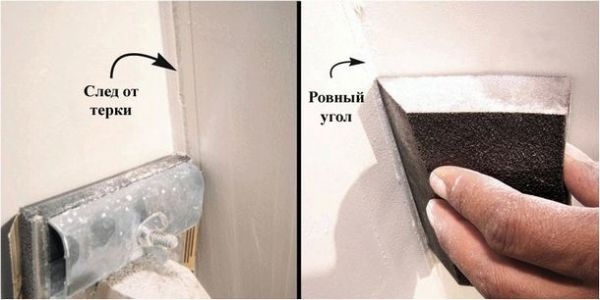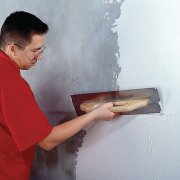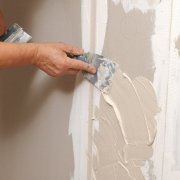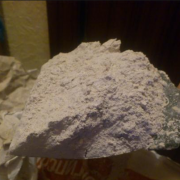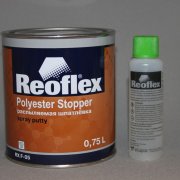How to grind walls after putty and how to do it right
The final stage of finishing is the most critical. And if you do it yourself, you need to do everything qualitatively, in accordance with the technology developed for each type of work, since there will be no one to ask if the result is unsatisfactory.
One of the stages of preparing walls for painting or stickering wallpapers is often overlooked by inexperienced finishers, namely, grinding them after applying a putty layer. In this article, we will talk about the need for grinding and the tools with which it is performed.
The content of the article
Why grind putty
If you are repairing not in the pantry, but in the living room, and you want the wallpaper to easily dock, not wrinkle and not peel off, and the paint lay on the walls perfectly, then you must grind the putty walls. And not once, but after each applied layer. And even if the surface looks even and smooth.
An exception can be made only for walls leveled by an excellent master who did not leave traces of spatula movement and accidental splashes on them. And only if you are going to paste them with thick vinyl or non-woven wallpaper (seeWallpaper decoration: choose the right one), which will hide minor flaws.
But the paint will not only not hide them, but also emphasize, reveal. Especially glossy. Therefore, for painting the walls are polished completely and very carefully, and for the wallpaper you can get by with local work - polishing only those areas where defects have been identified.
Tip. To detect all sagging, pits and other irregularities, direct a beam of bright light from one side of the wall at a slight angle. You will immediately see them in cast shadows.
How and what to grind
To begin with, grinding is a rather dusty process, so for work you should get a respirator or at least a medical mask, gloves, goggles. This requires safety instructions, as fine dust can damage the mucous membranes, settle in the lungs or cause allergies.
The room in which grinding will be performed must be isolated from other rooms by tightly closing the doors or, if they are not, hanging the openings with a dense, damp cloth.
Note. The walls are sanded not earlier than a day after the putty is completed, but before they are primed, since the strong film created by the primer will make this process almost impossible.
Choose a tool and abrasive
For self apartment repair or a small house, it makes no sense to purchase an electric grinder - it costs a lot, and the quality of grinding is worse than manual. In addition, in hard-to-reach places you still have to act manually.
Therefore, you will need a sanding grater with convenient mounts for abrasive material - mesh or sandpaper.
How to sand putty on the walls better - sandpaper or mesh?
Choose for yourself:
- The advantage of the abrasive mesh is its perforated structure. The dust formed by the grid does not linger on the tool, but passes through the cells without clogging the work plane.
It is quite wear-resistant, it will have to be changed less often than sandpaper, and you will learn about the need for replacement by the type of mesh that starts to wear out, or by reducing the quality of grinding.
- Sandpaper is still more familiar to many grinding material, which can be sold in sheets, rolls, or pieces already cut to the size of standard graters. Its advantage is a lower price than the grid.
However, sandpaper quickly becomes unusable, and will have to change it more often. In addition, it quickly becomes clogged with construction dust, and if a relatively large piece of putty gets stuck in it, it will scratch the smoothed surface, leaving traces on it.
If you still decide to choose sandpaper as an abrasive, then pay attention to its grain size. For rough processing of the starting putty layer, a material with a sufficiently large grain (P60 - P80) is suitable, but to bring the finish layer to smoothness it should be a fine-grained sandpaper (P100 and higher).
In addition to the grater, a grinding sponge with beveled edges for corner processing can also be useful to you. But in its absence, it is quite possible to use some auxiliary objects or just fine-grained sandpaper folded in half.
Grinding technology
Visually, this process is quite primitive, but here there are subtleties and tricks.
We will tell you in detail how to grind the walls after puttying correctly:
- Wait until the putty is completely dry. Do not start work until you are sure that he has gained the necessary strength;
- Fix the abrasive on a grater, do not forget about protective equipment, prepare a stepladder, a searchlight and a small spatula, and you can start;
- First remove the obvious tubercles with a spatula, if any;
- Then, starting from the top of any angle, in a circular motion begin to process the wall in small sections, highlighting them with a spotlight;
- Do not press the grater too hard, especially if you are grinding the top coat of putty (seeLatex putty: use cases), otherwise you just wipe it completely;
- Grind only bumps and protrusions, do not try to level the pits and holes: they are sealed with putty, allowed to dry, and then the surface is finished again;
- First process the entire area of the walls, and then the inside and outside corners.
That's basically it. It remains to prime the walls, wait for the primer to dry and proceed to the most pleasant job - applying a decorative coating.
Conclusion
Almost any work to repair your own housing can be done independently if you know how to do it right. Grinding is the simplest of them, albeit rather dirty and time-consuming. To master it perfectly, the video in this article will help you.





